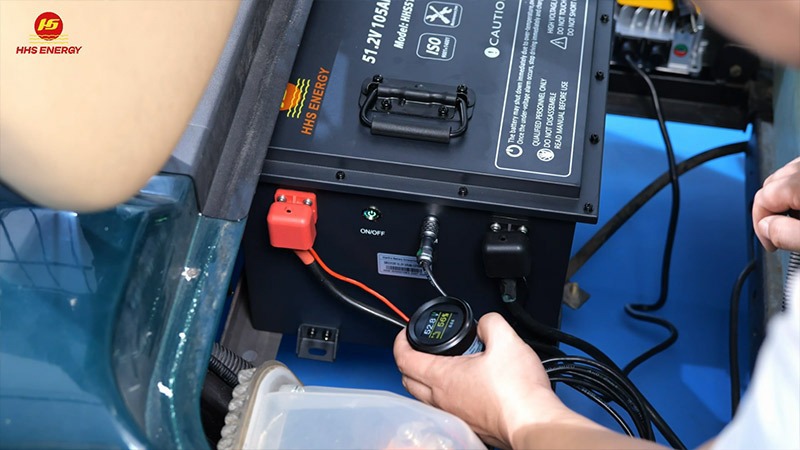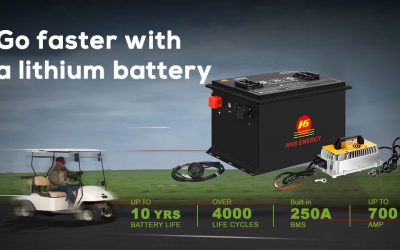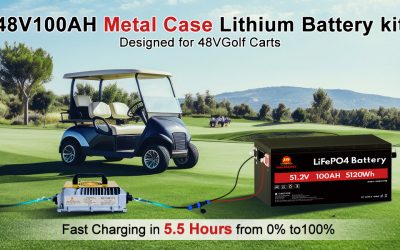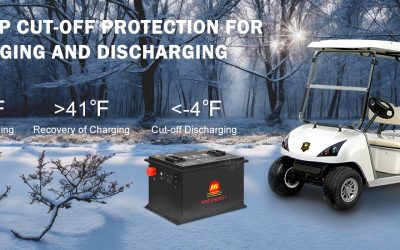How Many Years Should Golf Cart Batteries Last?

Golf carts are essential for navigating fairways, moving around gated communities, and even industrial sites. But when it comes to their power source, the battery is the most crucial—and costly—component. One of the most common questions golf cart owners ask is: “How long should my golf cart batteries last?”
The lifespan of golf cart batteries depends on several factors, including battery chemistry, usage patterns, and maintenance habits. Let’s dive into the expected lifespan of different battery types, tips for maximizing their longevity, and a comparison chart of key parameters to help you choose the right one for your cart.
1️⃣ Understanding Battery Lifespan
Battery lifespan is typically measured in charge cycles—the number of complete charge and discharge cycles a battery can handle before its capacity drops below 80% of its original capacity.
Here’s a quick overview:
-
One cycle = discharging from full to empty and then recharging to full.
-
Partial discharges (using only part of the charge) can extend cycle life.
-
Heat, deep discharges, and poor maintenance can all reduce lifespan.
2️⃣ Lead-Acid Batteries
Traditional lead-acid batteries have been the workhorse of golf carts for decades. They’re affordable and reliable but require regular maintenance, such as checking water levels and cleaning terminals.
-
Average Lifespan: 3–5 years
-
Cycle Life: 300–500 cycles (flooded lead-acid)
-
Maintenance: Regular water refilling, corrosion prevention
These batteries are sensitive to deep discharges and poor charging practices. Letting them sit in a discharged state can quickly shorten their lifespan.
3️⃣ Lithium-Ion Batteries (Li-ion)
Lithium-ion golf cart batteries are becoming increasingly popular because they offer higher energy density, faster charging, and no maintenance.
-
Average Lifespan: 8–10 years
-
Cycle Life: 2,000–5,000 cycles
-
Maintenance: None (sealed, maintenance-free)
They’re more expensive upfront, but their long lifespan and low maintenance make them a great long-term investment.
4️⃣ Lithium Iron Phosphate (LiFePO₄)
A subtype of lithium-ion, LiFePO₄ batteries are particularly popular in golf carts because of their superior safety and long cycle life.
-
Average Lifespan: 10+ years
-
Cycle Life: 2,000–6,000 cycles
-
Safety: Very high (less risk of thermal runaway)
They are ideal for users who want maximum durability and performance without worrying about maintenance.
5️⃣ Emerging Options: Sodium-Ion and Others
Sodium-ion batteries are an exciting new option for large-scale applications, but they are not yet common in golf carts. For now, lithium-ion and lead-acid remain the main contenders.
🏆 Key Factors That Influence Battery Lifespan
Regardless of battery chemistry, the following factors heavily influence how long your batteries will last:
✅ Depth of Discharge (DoD): Shallow discharges extend lifespan.
✅ Charging Habits: Frequent top-ups are better than deep discharges.
✅ Temperature: High heat or freezing temperatures shorten lifespan.
✅ Maintenance: Only lead-acid batteries need watering and terminal cleaning.
✅ Charging Equipment: Using the correct charger prevents undercharging or overcharging.
📊 Battery Comparison Table
| Battery Type | Cycle Life | Average Lifespan (Years) | Maintenance | Weight | Charging Speed | Cost (Relative) | Applications |
|---|---|---|---|---|---|---|---|
| Flooded Lead-Acid | 300–500 cycles | 3–5 | High (water checks) | Heavy | Slow | Low | Traditional carts, budget-friendly |
| AGM Lead-Acid | 400–600 cycles | 4–6 | Low | Heavy | Moderate | Moderate | Rental fleets, low-maintenance carts |
| Li-ion (NMC) | 2,000–4,000 cycles | 8–10 | None | Light | Fast | High | Modern carts, performance upgrades |
| LiFePO₄ | 2,000–6,000 cycles | 10+ | None | Light | Fast | High | Premium carts, top-tier performance |
🔧 How to Extend Your Golf Cart Battery Life
No matter which type you choose, here are some essential tips:
🔹 Use the Correct Charger: Lithium batteries need a lithium-specific charger; lead-acid batteries have different voltage and charging profiles.
🔹 Avoid Deep Discharges: Keep lead-acid batteries above 50% charge whenever possible; lithium batteries are more tolerant but still prefer shallower cycles.
🔹 Store Properly: If storing your cart for the off-season, ensure batteries are fully charged and stored in a cool, dry place.
🔹 Regular Maintenance for Lead-Acid: Check water levels monthly and clean corrosion from terminals to maintain good electrical contact.
💡 The Bottom Line: How Many Years Should You Expect?
-
Flooded Lead-Acid: 3–5 years (with maintenance)
-
AGM Lead-Acid: 4–6 years (lower maintenance)
-
Lithium-Ion (NMC or similar): 8–10 years
-
Lithium Iron Phosphate (LiFePO₄): 10+ years
Ultimately, the best battery for you depends on how often you use your golf cart, your budget, and how much maintenance you’re willing to handle.
🚀 Final Thoughts
Golf cart batteries are an investment, so it pays to understand their lifespan and how to care for them. Lithium options offer incredible longevity and minimal maintenance, making them ideal for those who want the most hassle-free experience. Meanwhile, traditional lead-acid batteries remain cost-effective for light, seasonal use—if you don’t mind some regular upkeep.
Ready to extend your golf cart’s battery life? Choose wisely, maintain well, and you’ll enjoy years of reliable cruising on the course!





